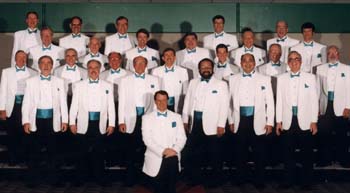![[Metroactive News&Issues]](http://metroactive.com/gifs/news468.gif)
[ San Jose | Metroactive Central | Archives ]
In Harmony's Way
Saving the barbershop quartet
By Will Harper
ED BEJARANA is instructing his pupils to relax. "Rub your hands together," he gently advises the 25-some crooners assembled before him inside Room M3 of Palo Alto's Cubberley Community Center. "Close your eyes."
In a soothing, encouraging tone, he tells everyone to breathe deeply. I start worrying that maybe I have mistakenly entered the room where the yoga class is being held. But then Bejarana starts snapping his fingers.
"Breathe in tempo," says Bejarana, a retired, pear-shaped musician from Santa Cruz.
The sound of men sucking wind fills the tiny music classroom. Breathe in. Breathe out. Breathe in. Breathe out.
Then Bejarana tells everyone to start their "ooooos." After they've gotten their ooooos out, then it's time for the "eeeees." Then ooooo-eeeee, ooooo-eeeee. Now they add a little "aaaaahhh." Ooooo-eeeee-aaaaahhh.
The tenors now go higher, but the baritones stay low. This is starting to sound musical. A little like a Gregorian chant even. But no self-respecting Gregorian chorus would warm up their tonsils with the next phrase Bejarana sings: "My mom, there is no one like my mom."
Then the group segues into a rendition of "Wild Irish Rose."
So begins this week's gathering of the Peninsula chapter of the Society for the Preservation and Encouragement of Barber Shop Quartet Singing in America. The barbershop chorus is warming up and rehearsing for its annual stage show, Little Barbershop of Horrors, Feb. 19 at the Mountain View Center for the Performing Arts.
The show was written by Peninsula chapter director Steve Sammonds, a product scheduler for game-maker Electronic Arts. At age 38, Sammonds is one of the younger fans of barbershop harmony, which attracts mostly gray-hairs.
An uncle in Baton Rouge, La., was the first person to expose Sammonds to the barbershop style. Though Sammonds didn't become a harmony hound right away, he eventually got hooked. He became director of the local barbershop society in 1989, when he was a mere twenty-something.
"I think the allure for most men who sing barbershop is the sound," Sammonds says. "There's a certain feel when you ring a barbershop chord--it locks in."
Sammonds admits he doesn't have much formal musical background of which to speak. He took music classes in grade school and a theory class in college. But then, a lot of barbershoppers don't have a formal musical background. Take sasquatch-size Bert Laurence, who is standing next to me singing bass harmony. Between ooooo-eeeee-aaaaahhhs, the 60-year-old retired software engineer tells me that before getting into barbershop 20 years ago, his only musical experience had been in an eighth-grade operetta version of Tom Sawyer.
"I thought I'd be terrible," he says of his second foray into the world of song. "Then I went to a [barbershop] rehearsal and found out I could do it."
Then Laurence asks me if I'd like to join the club. "No thanks," I reply. I'm not sure if the world is ready to endure both my writing and my singing.
The Society for the Preservation and Encouragement of Barber Shop Quartet Singing in America boasts 34,000 members in 809 chapters throughout the United States and Canada. Sammonds says that barbershop attracts people from all different walks of life.
Barbershop is a cappella, four-part harmony with a lead, bass, tenor and baritone. According to the society's literature, American barbershop style first surfaced in black Southern quartets in the 1870s. The first written use of the word "barbershop," however, didn't come until 1910 with the song "Play That Barbershop Chord."
The society's historians say that barbershop harmony ensemble was indeed sung at barber shops, but those weren't the only places. Anywhere men regularly gathered--a street corner or a woodshed--could serve as a suitable venue for a spontaneous outburst of four-part harmony. The popular songs of the late 19th and early 20th centuries, with their sentimental lyrics and uncomplicated melodies, lent themselves to the four-part barbershop harmony.
The decline of barbershop coincided with the decline of vaudeville. Dance tunes of the 1920s and more complicated melodies played on the radio by professional musicians were not barbershop friendly. Still, barbershop survived the 20th century and attracted the likes of President Harry Truman and crooner Bing Crosby. Modern TV shows, including Beverly Hills 90210 and The Simpsons, have featured barbershop quartet performances.
"The sound is still recognizable," observes Steve Sammonds. "People just don't think it's around anymore."
[ San Jose | Metroactive Central | Archives ]
Copyright © 1999 Metro Publishing Inc. Metroactive is affiliated with the Boulevards Network.
For more information about the San Jose/Silicon Valley area, visit sanjose.com.
![]()

From the February 17-23, 2000 issue of Metro, Silicon Valley's Weekly Newspaper.